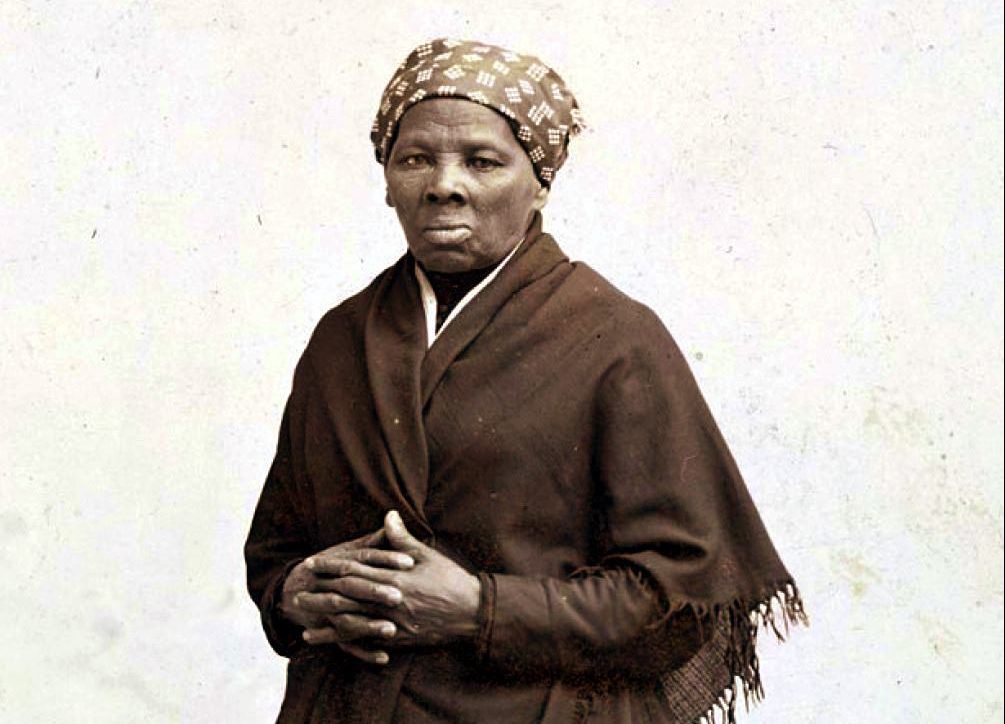Minty was on her way to the dry-goods store for supplies when she came across a slave who she knew worked for a nearby family.
He had wandered off without permission and there was an overseer in close pursuit. When the overseer came upon the two of them talking, the overseer angrily ordered Minty to restrain him.
Minty was twelve years old.
Minty refused, allowing the slave to get away.
Now when Stan Lee told a similar story, the guy Peter Parker didn’t stop from getting into the elevator ends up killing his Uncle Ben and Peter Parker learns a valuable lesson that with great power comes great responsibility.
That is not the path that Minty’s story takes… at least not initially.
This overseer was so angry that Minty had let this slave get away that he tossed a two-pound weight at his fleeing slave but the weight hit Minty instead.
Head shot.
Minty was knocked out cold.
In her own words Minty said that the weight “broke my skull”.
Minty later rationalized that the ONLY reason she survived the direct hit from the weight was that her hair had “NEVER been combed and stood out like a bushel basket” cushioning the blow.
Again, Minty was twelve years old and she had never had her hair combed.
If it wasn’t clear before it should be by now.
Africans were brought to America for one purpose and one purpose only, to work.
It was not at all uncommon for the most productive slaves to pick five to six hundred pounds of cotton a day for a week at a time, in return for only the bare necessities of life.
As was discussed before, enslaved Africans had been in America since 1619 and yet by 1830 (211 years later) the vast majority of slave owners had never bothered to teach them any more English that was necessary to perform the tasks assigned to them.
And evidence of that is the classic southern drawl that is known the world over today.
The distinctive Southern drawl we know today is the result of the unintended consequence of slave owner’s children learning English by imitating the broken English of their enslaved African caretakers, who pronounced the few English words they knew with heavy African intonation and elision of syllables.
Eventually Minty was carried back to her slave quarters where she laid bleeding, coming in and out of consciousness for two days without any medical attention at all.
Remember doctors cost money and slave owners were in the habit of budging exact $0 dollars for medical treatment for slaves.
It was after this traumatic head injury that the seizures began. Minty would suffer seizures for the remainder of her life.
Considering what Minty would grow up to do with her life, the second side effect of her head injury just seems like a cruel joke.
In addition to the seizures, Minty would also fall asleep, suddenly, without warning, and when she did no one would be able to wake her.
Shaking, yelling, pinching even dousing her with cold water…nothing would wake her.
Minty would claim that while she was sleeping she would still be aware of everything that was going on around but she would be unable to awake herself.
Minty’s parents were Rit Green and Ben Ross. Minty’s parents were not unlike many slave marriages in that husband and wife often lived on different plantations and therefore answered to different Masters and Mistresses.
Minty’s mother Rit was owned by a woman named Mary Pattison Brodess (and later her son Edward). Her father Ben was held by a man named Anthony Thompson.
Rit was a cook for the Brodess family. After the death of Mary Pattison Brodess she was willed to Mary’s son Edward.
Edward Brodess wasted no time selling not one, not two, but three of Rit’s daughters away to other plantations.
Rit never saw these daughters again.
When Edward Brodess decided that he could get good money selling Rit’s youngest son Moses, Rit made arrangements to save him by hiding Moses from Edward. She must’ve been a well-liked woman because with the help of other slaves including some free blacks in the area they managed to keep Moses hidden from Edward Brodess for over a month. Then one day a “Georgia man” along with Edward came to her slave quarters to take Moses away but Rit told him, in no uncertain terms, that “the first man that comes into my house, I will split his head open”.
Edward Brodess finally got the message and that was that.
Minty witnessed her mother’s moment of defiance and credited this eye opening experience with opening her mind to the possibility of resisting the will of men who were wholly unaccustomed to being told “No”.
But truth be told, Rit didn’t tell Edward “No”. She said she would “split his head open.”
He might not have understood “No” but he understood that.
The breaking up of the black family was very common but that didn’t make it any less traumatic for parents and children, as you can imagine. I remember reading in one slave narrative about how a woman had her baby pulled from her arms because he was sold to pay a gambling debt.
She never saw her infant son again.
When Minty was 18 years old in 1840 her father was manumitted at the age of 45 as was stipulated Anthony Thompson’s will.
Although her father was now free he continued to work as a timber estimator and a foreman on Thompson property. This too was not uncommon.
People assume that if you were set free then you just went frolicking into the sunset.
Maybe you wanted to but where did you go? Freedomland?
Being a slave meant that you didn’t get paid. This meant that your survival was entirely dependent on someone else.
Being free meant that you had no money, you were probably illiterate, homeless, hungry and had only the clothes on your back.
Without assistance there was no way you could survive only on freedom.
That is why, without exception, no slave ever successfully made it to freedom without the assistance of someone.
The circumstance of slavery necessitated that.
When Minty was 22 she married a free black named John Tubman. Soon after her marriage, maybe even on that very same day, Minty changed her name from Araminta “Minty” to Harriet.
Minty (Harriet) had something up her sleeve.
Since Harriet was a slave, any children born of John and Harriet, or Harriet and anyone for that matter, would be slaves. Knowing how much of an a-hole Edward was to her family the last thing Harriet was looking forward to was giving him more children to sell. But Harriet also suspected somehow that Edward was even more of an asshat than meets the eye.
Knowing how her father was freed, Harriet hired a lawyer through her husband John Tubman to look into her mother Rit’s legal status. What the lawyer discovered was that it wasn’t just her father who had been manumitted but her mother had been as well when her mother turned 45. And that her mother’s free status not only applied to her but to all of her surviving children, including Harriet.
Edward the asshat had simply ignored this clause in his mother’s will and with the whole lot of them being illiterate and ignorant of being manumitted, her mother Rit, Harriet, and everyone else simply continued living and working as his slaves.
And the worst part about it was that there was nothing Harriet could legally do about it.
In 1849 Edward Brodess decided it was time to sell Harriet. She had fallen ill and Edward figured he could pass her off on some unsuspecting dope before she really was worthless.
But Harriet was so angry now, especially after learning that he was keeping her family in bondage because he simply ignored the wishes of his own mother, Harriet said she prayed for God to do something about him.
“Oh Lord,” she prayed “if you ain’t never going to change that man’s heart, kill him, Lord, and take him out of the way.”
A week later Edward Brodess died.
And Harriet amazingly expressed regret for praying that God would kill him instead of relishing her new found mutant power and joining the X-men like I would’ve done.
But the untimely death of Edward Brodess, although convenient, only put her in more danger of being sold. In fact, his widow Eliza began working almost immediately on selling all of the family’s slaves.
Had that happened everyone would’ve been scattered to the wind and most likely never reunited again.
That is when Harriet decided it was time she took her fate into her own hands and make a break for it.
“[T]here was one of two things I had a right to,” she explained, “liberty or death; if I could not have one, I would have the other.” To Be Continued…

